#Cosewic
Text
Unlocking the Secrets of Saskatchewan's Mushrooms
In the realm of fungi, Mushroom Day takes center stage on April 16th, inviting enthusiasts to delve into the fascinating world of mushrooms. With over 14,000 varieties, these fungal wonders grace dark and damp corners, adding a touch of mystery to the natural world.
Mushrooms and fungi
Despite their allure, caution is paramount. Harvesting mushrooms requires more than just an appreciation for…

View On WordPress
#biodiversity#Citizen Science#City Nature Challenge#Cosewic#COSEWIC Assessment#Ecological Awareness#ecological balance#environmental stewardship#Forest Biodiversity#Forest Exploration#Fungal Chronicles#Fungal Diversity#Fungal Ecology#Fungal Kingdom#Fungal Kingdom Exploration#Fungal Wonders#fungi#Fungi Appreciation#George Genereux Urban REgional Park#iNaturalist#iNaturalist app#Mushroom Day#Mushroom Discovery#Mushroom Enthusiasts#Mushroom Foray#Mushroom Identification#Mushroom Kingdom Celebration#Mushroom Photography#Mushroom Safeguarding#Mushroom Science
0 notes
Text
This is not for gatekeeping, I just wanna spout some turtle facts bc I'm a fucking nerd
THE FLAT FUCK FRIDAY MEMES WITH DONNIE ARE FUNNY AS FUCK
Though, these fellas aren't spiny soft shells!

It's the Asian giant soft shell turtle! / Cantor's giant soft shell turtle!

Some differences:
- Spiny softshells are native to North America, spanning from Central-Eastern U.S. all the way down to Northern Mexico, and a little bit into Canada.
- Asian giant softshells are native to Southeast Asia, all the way from Bangladesh to the Philippines, and even spread a bit further out, like in Eastern South India.
- Spiny softshells' carapaces are rougher by its head, spines along the front edge which give it its name. They are also known to "resemble pancakes."
- Asian giant softshells have a smooth carapace all around. It almost blends into their neck.
- Spiny softshells have a snorkel-like nose, 2 yellowish lines on the sides of its head.
- Asian giant softshell turtles have a broad head that ends in a shorter snout, eyes sitting close to it. For this reason, it's also called a "Frog-Faced turtle"
- Adult female spiny softshell's carapaces can grow to 7 up to 19 inches in length. Adult male spiny softshells can go from 5 to 10 inches.
- The general range of size for an adult Asian giant softshell's carapace is 28-39 inches in length.
- Though not listed as not endangered in the US (put as 'least concerned' in the IUCN), spiny softshells are considered endangered in Canada (listed as 'endangered' by COSEWIC, SARA, and 'threatened' by ESA).
- The Asian giant softshell turtle is classified as critically endangered by the IUCN (Though said they need to be reclassified due to more concerns). It's considered an EDGE species, Evolutionarily Distinct and Globally Endangeted.
This has been turtle facts with Buwan! Again! :)
some other related posts abt turtle facts!
#rottmnt donnie#flat fuck friday#turtle facts with ROTTMNT because I cannot shut up#donatello hamato is the softshell ever#regular buwan reblog#turtle facts n tmnt
178 notes
·
View notes
Text
Turtles of Ontario
Beneath the calm surface of Ontario’s lakes and rivers lives an animal that has occupied the area for longer than any human civilization. But with the changes of the modern world, the ancient turtles of Ontario that once represented protection and longevity are quickly fading from existence. In today’s blog post, I will be exploring my favourite animal, the turtle, and share with you the unfortunate story of how this elder of the animal world has become rare in their native habitats, and how if action is not taken, we may never be able to see them again.
There are eight species of turtle that can call Ontario their home, the most of any Canadian province, each with unique characteristics that set them apart from the others. Turtles are reptiles that belong to the order Testudines, they have hard shells that have developed from their ribs and can hide their heads and limbs within the shell when threatened. Most turtles can be identified based solely on the patterns, size, and shape of their shells. One of the most commonly seen turtles in Ontario is the painted turtle. If you see a bunch of turtles lying on a log or rock, you’ve likely seen a painted turtle! These turtles love basking in the sun near the lakes, ponds, rivers, and wetlands that they live in. They are aquatic, spending most of their time in the water but will travel onto land to migrate, nest, and bask. They have a unique pattern of red stripes on their shells and limbs which can be seen in the picture below (COSEQIC, 2018).

The largest turtle in Ontario is the Snapping turtle, which can grow to 40cm in length! They are known not only for their size but also for their powerful bite, which they get their name from. Although their shells are large, their underside is not well protected, and they cannot fully retract their head and limbs (OTCC, 2023).

Another fascinating species is the Northern Map turtle, which lives in bodies of water in and around the Great Lakes. They get their names from the unique pattern on their shells of intricate lines that resemble that of a topographical map. They also like to bask on logs and other surfaces near the water but are quick to startle and will dive into the water at the slightest movement (OTCC, 2023).
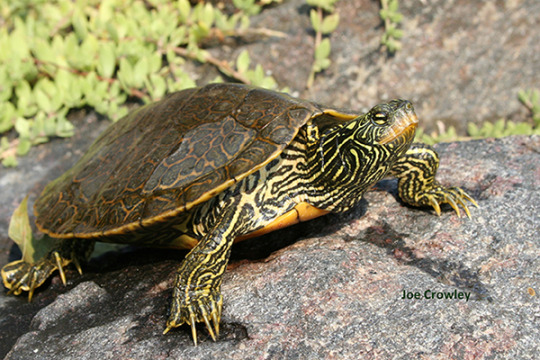
Unfortunately, seven of the eight Ontario species are considered at risk of extinction if steps are not taken to conserve their populations. They all face similar threats from human activities and suffer the most from roadway accidents, loss of habitat, and invasive species (OTCC, 2023). Turtles have long lives but take many years to reach sexual maturity, resulting in low rates of population growth. This combined with increased adult mortality has made population recovery a slow and difficult process. Being able to identify the different species of turtles in Ontario is crucial for reporting and monitoring their populations. There are many citizen science initiatives and reporting turtle sightings is an important step in their conservation. This can be done at the following website, but many others can be found with a quick search: https://www.ontario.ca/page/report-rare-species-animals-and-plants
COSEWIC. (2018). COSEWIC assessment and status report on the Midland Painted Turtle Chrysemys picta marginata and the Eastern Painted Turtle Chrysemys picta picta in Canada. Committee on the Status of Endangered Wildlife in Canada. Ottawa.
OTCC. (2023). Our 8 Native Species Need Our Help! Ontario Turtle Conservation Centre, retrieved from: https://ontarioturtle.ca/turtles/
5 notes
·
View notes
Text
Facts about Shortfin Mako

Shortfin Mako are sleek and spindle shaped with a long pointed snout, short pectoral fins, and a crescent shaped caudal (tail) fin (Figure 1). The second dorsal (top) fin is much smaller than the first. The top of the shark (dorsal side) is dark blue with a band of metallic indigo blue on the sides and the bottom (ventral side) is white. Shortfin Mako have slender, slightly curved teeth, with no lateral cusps, and the teeth are visible when the mouth is closed. Their diet includes fish, squid, marine mammals and smaller shark species. Females can reach over three metres in length. With increasing size, a shift to larger prey likely occurs.
Shortfin Mako are slow growing, relatively late to mature, and have a low reproductive rate. The reproductive cycle is between two to three years and litters range from four to 16 pups. Estimated generation time is approximately 25 years.
Status designation of Shortfin Mako in Atlantic Canadian waters
COSEWIC assessed the Atlantic population of Shortfin Mako as threatened (April 2006) and special concern (April 2017); however, based on new information, the population was reassessed as endangered in May 2019.
Why are Shortfin Mako assessed as endangered?
Shortfin Mako are vulnerable to fishing pressure due to life history characteristics, including relatively slow growth rates, late age of maturity, and low reproductive rates. Fishing pressure is currently the only threat identified for this population. In 2017, the International Commission for the Conservation of Atlantic Tunas (ICCAT) carried out a comprehensive assessment of Shortfin Mako. ICCAT concluded that the North Atlantic Shortfin Mako population is depleted and over-fishing
above sustainable levels is continuing. Since 1994, annual catches of Shortfin Mako have averaged 3,685 metric tonnes (mt) in the North Atlantic, with an average of 67 mt coming from Canada. There are no fisheries targeting Shortfin Mako in Canadian waters. However, Shortfin Mako are caught as bycatch in a number of fisheries, primarily in pelagic fisheries (i.e., water column) and, to a lesser degree, benthic (bottom) longline fisheries. As of April 2021, the retention of Shortfin Mako bycatch is not permitted in any Atlantic Canadian commercial fishery or recreational fisheries.
Status and Conservation
Shortfin mako sharks are also super athletic. They are known for their speed and aggressiveness—traits which also make them a prized catch for sportfishers. Shortfin mako sharks are known to fight hard and jump out of the water when hooked, which means fishing for them becomes a desirable challenge. Unfortunately, shortfin mako sharks can easily get entangled in longline fishing gear as bycatch even when fishers are not specifically trying to catch them. Commercial and recreational fishing worldwide, on top of shark finning killing them for their fins, has greatly decreased their populations. Also, because they are highly migratory fish that cross international boundaries, countries need to work together to set regulations that help protect them from overharvest. Shortfin mako sharks were recently reclassified from “Vulnerable” to “Endangered,” which means their populations are declining and are at heightened risk of extinction.
2 notes
·
View notes
Text
PRACTiK
Coser arregla el alma ❤ PRACTiK es una tienda de telas bonitas y mercería práctica para tus proyectos de costura.❤ Es un espacio creativo para l@s amantes del hilo y la aguja.
1 note
·
View note
Text
Pika mouse

#Pika mouse free
Sugimori and Nishida don’t explain why the two-evolution requirement was dropped, but it’s pretty easy to imagine it was a result of Pikachu’s design being unbelievably adorable. Odds are when Nishida showed her design to the rest of the staff, the reaction from many was “looks like a mouse,” making the name “Pikachu” a perfect fit.īut wait, what about the stipulation that the character be able to evolve twice? Pikachu can only evolve once, into Raichu (though later games added in the diminutive Pichu as the lowest level of the evolutionary path). As a matter of fact, squirrels themselves aren’t nearly as common in Japan as they are in rural and suburban communities in America, and if you live in a Japanese city, you could easily go several years without seeing one, even in parks. So why did the character end up being called Pikachu instead of Pika-whatever-squirrels-say-in-Japanese? Probably because there’s no set onomatopoeia for a squirrel’s cry in Japanese. So she turned to the animal kingdom for inspiration, and took design cues from…a squirrel!
#Pika mouse free
The only specific guidelines Nishida was given were that the character should be cute, use electricity-based powers, and be able to evolve twice.Īside from those criteria, Nishida was free to do whatever she wanted in terms of design. Ken Sugimori, head of Pokémon video game developer Game Freak, and Atsuko Nishida, an illustrator who contributed monster designs for the series’ original Pokémon Red and Green installments in 1996, recently reminisced about Pikachu’s origin. It’s the perfect name for a character that’s essentially an “electric mouse,” right?Įxcept, it turns out that Pikachu’s visual design wasn’t based on a mouse at all. As a matter of fact, the franchise mascot is so famous that even most non-Japanese speaking fans know that his name comes from a pair of Japanese onomatopoeias: pika, referring to a flash of light, and chu, the squeaking sound mice make. Slowpoke? Over here he’s “Yadon,” a syllabic jumbling of doya, which refers to a sort of blissful cluelessness.īut Pikachu’s name is the same around the world. For example, the Pocket Monster called Magikarp in English versions of the game/anime? In Japan, he’s “Koiking,” since he’s essentially a koi (“carp”) with a crown-shaped fin on his back. Perhaps my strangest experience with learning Japanese has been having to remember two sets of names for Pokémon species. Leaves of Mountain Avens, lupines, vetches, grasses and shrubs.Original designer reveals that the real inspiration for the “electric mouse” was a different animal altogether. The pikas call is a loud, distinctive “meeeep” and they use it to declare their territories. They are solitary creatures preferring to stay 20 to 75 metres away from their neighbours. They do not hibernate and so must have a food supply on hand to survive the cold months. Inconspicuous bobbed tail, long whiskers.Ĭollared Pikas spend the summer months raising young and collecting plants into hay piles among the rocks to save for the winter.Small chubby body with short limbs and rounded ears.Read the Protocol for detecting Collared Pika. Voluntarily report your observations to the Yukon Conservation Data Centre. The Committee on the Status of Endangered Wildlife in Canada (COSEWIC) has assessed Collared Pika as a species of Special Concern. In late summer and fall, look for conspicuous collections of plants, called ‘hay piles’ among the rocks.Once near its home territory, you may find that the pika will approach within a few metres, if you are able to remain nearly motionless and quiet for a few minutes.Hone in on the call and watch for movement among the rocks, or a silhouette of the pika against the sky. Although they are heard, they are not necessarily easy to see as they camouflage perfectly among the rocks. They can be easily found because of their alarm call that carries across the alpine when you walk by.Collared Pikas live in rock talus patches high in the alpine.Coney, Rock Rabbit, Whistling Hare Viewing opportunities

1 note
·
View note
Photo

Yellow-banded #bumblebee (#Bombus terricola) is a #SARA & #COSEWIC listed #bee of Special Concern; it’s numbers have declined greatly since the 1990s. Here’s one today feeding on #vetch in #CapeBretonHighlandsNationalPark . #nature #insects #Apidae #Hymenoptera #SpeciesAtRisk #entomology (at Cape Breton Highlands National Park) https://www.instagram.com/p/B0n9EQGnnHl/?igshid=wzdmh9ly4gt2
#bumblebee#bombus#sara#cosewic#bee#vetch#capebretonhighlandsnationalpark#nature#insects#apidae#hymenoptera#speciesatrisk#entomology
5 notes
·
View notes
Text

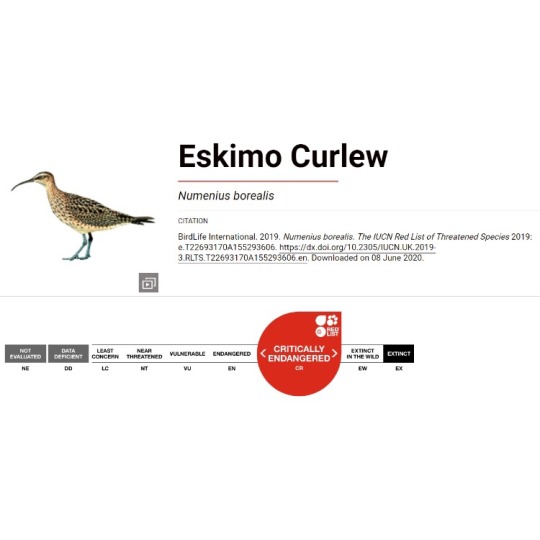
Eskimo Curlew
Critically endangered
Number of mature individuals: 0-49
Threats: Agriculture & aquaculture, energy production & mining, biological resource use, climate change & severe weather
Conservation: CITES Appendix I & CMS Appendix I & II. Protected in Canada, USA, Argentina & Mexico. Further conservation awareness is critical for the species, as the government of Canada has declared that the recovery of the species in Canada is not technically or biologically feasible at this time.
Organizations involved in conservation to be recognized & supported: COSEWIC
Source: https://www.iucnredlist.org/species/22693170/155293606
#white out tuesday#signal boost#i apologize for the problematic name bc of the e word#but this one really hit different#idk maybe bc i took an arctic ecology course or somethin but this one actually made me cry#less than fifty of them in the wild and the government is like...hmm no cant do anything sry#and theres no organizations supporting them directly the only reason i have cosewic is bc they do general conservation#:—/ this rly hurtin me yall i wanna do something about it but i dont know what i can do
0 notes
Text

After an absence of more than 50 years, the swift fox has returned to the grasslands of the Fort Belknap Indian Reservation in Montana. From Sept. 12 to 20, the Assiniboine (Nakoda) and Gros Ventre (Aaniiih) Tribes of Fort Belknap released 27 swift foxes [...], kickstarting a five-year swift fox reintroduction program. [...] The swift fox is the latest extirpated species to return to Fort Belknap, joining other iconic prairie species successfully reintroduced to tribal lands under the leadership of the Fort Belknap Fish and Wildlife Department. Historically, swift foxes lived across much of North America’s Great Plains. “Along with buffalo and endangered black-footed ferrets, swift foxes are now back where they belong [...].”


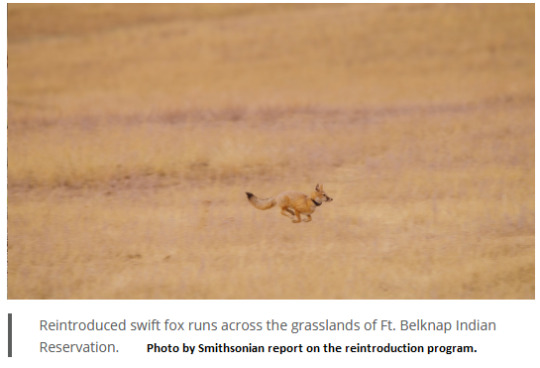
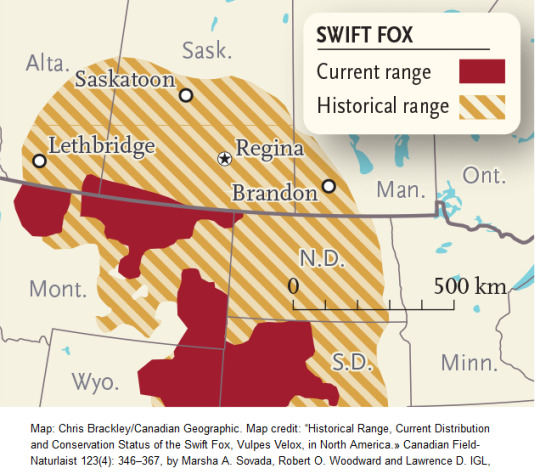
The goal of the program is to establish a self-sustaining population of swift foxes on the Reservation. For the September release, 27 swift foxes were translocated to the Fort Belknap Indian Reservation [...].
Swift fox numbers declined precipitously in the late 1800s, mainly due to poisoning intended for coyotes and wolves and the loss of grassland habitat. During this same time they were also eliminated from the northern portion of their range. Swift foxes made a comeback after successful reintroduction efforts began in 1983 in Canada and on the Blackfeet and Fort Peck Indian Reservations in Montana. However, these reintroduced populations have yet to reconnect with populations in the southern portion of their historic range. Establishing a population of swift foxes on the Fort Belknap Indian Reservation will expand the species’ occupied range in the north and help bridge the distribution gap between existing populations to the north and south. [...]
Swift foxes (Vulpes velox) were reduced to about 5% of their historic numbers across their range and completely extirpated from the northern Great Plains in the 1800s and 1900s primarily due to poisoning and trapping campaigns aimed at coyotes and wolves. [...]
The Fort Belknap swift fox reintroduction marks the eighth effort of its kind. Swift foxes were previously reintroduced in Saskatchewan and Alberta, Canada (1983-1997); Blackfeet Nation, Montana (1998-2002); Bad River Ranches, South Dakota (2002-2007); Badlands National Park, South Dakota (2003-2005); Fort Peck Reservation, Montana (2006-2010); and Pine Ridge Reservation, South Dakota (2009-2010). [...]

[Map by federal Canadian government, COSEWIC.]

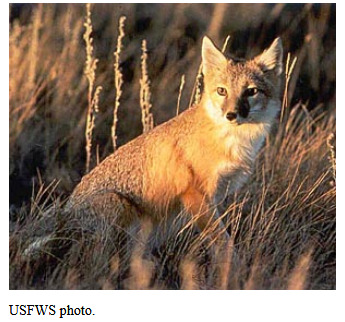
Headline and all text from: Smithsonian National Zoo Newsroom press release. “Tribes Begin Five-Year Swift Fox Reintroduction Program.” 23 September 2020. [Maps and photos added by me.]
108 notes
·
View notes
Text

Fish that Band Together: Banded Killifish in the Home Aquarium
A close relative of the more widely known (and distributed) Mummichogs, the Banded Killifish is an interesting choice for keeping in the home aquarium - and a better choice than its’ relative for freshwater keeping. Below is some information you should consider before selecting one or more of these guys for your home tank.
Species
Fundulidae (Topminnows) is one of the 10 families in the order Cyprinodontiformes (Toothcarps) along with Poeciliidae (Livebearers), Cyprinodontidae (Pupfishes), Rivulidae (Rivulines, New World Killifish), and Aplocheilidae (Killifish). Fundulus is a relatively large genus of 39 fish, all with different care requirements. Therefore the focus of this discussion will be:
Fundulus diaphanus (Banded Killifish) [pictured]
As far as I know, these fish are not sold at all in the trade - save for maybe through specialist dealers. Likely if you want one, you’ll have to collect them yourself.
Conservation Status
The Banded Killifish has been evaluated as Least Concern by the IUCN.
Description
The Banded Killifish is an elongated fish that can attain a maximum size of about 5 inches, though you’d be lucky to find one much above 3.5 inches. Males have a more prominent banding pattern on their sides and when in breeding condition gain a blueish iridescence. Females have a more subdued banding pattern with thinner bars; sometimes these aren’t overtly present at all. As with other Killifish, they do appear to have regional “variants” depending on where they are caught. The ones pictured were captured in Virginia.
Common for Topminnows, Banded Killifish are more territorial than aggressive on average. They will push other fish out of their turf but don’t typically continue to chase tankmates once they have fled. They can be tough on fish that don’t learn to stay out, though, such as some of the daces that swim all over the tank. They are more likely to leave fish alone that live on the bottom of the tank like darters and madtoms.
The best tankmates are either a) bottom feeders, or b) boisterous fish that can take care of themselves. Mudminnows, Darters, Madtoms, Mosquitofish, other Killifish, Fathead Minnows, and maybe Sticklebacks are all fair choices. In a brackish setting, consider Rivulines, native Gobies, Hogchokers, and maybe the smaller Sleeper Gobies.
As the name implies, these fish mostly inhabit the top of the tank, searching for floating morsels to eat. Their pattern makes them adept hiders and in a planted tank you may see them often lurking among the plants.
Feeding
I’ve found Banded Killifish to be very easy to feed. Dried Foods (flakes and pellets), frozen foods (brine shrimp, mysis shrimp, bloodworms, “marine” mixes), and live foods are all relished. They take to prepared foods right away - they push to be at the front of the chow line no matter what you feed.
Water Quality
Banded Killifish are best kept around room temperature (66-70 F), though can handle periods of much warmer or slightly cooler. They do best in basic, hard water - between 7.0 and 8.0 pH and 10-20 dH. They are more likely to inhabit smaller tributaries and marshes than fast moving streams, so ensure your tank turnover isn’t tumultuous.
Brackish Suitability
Banded Killifish thrive in brackish conditions. Laboratory tests showed they adapt well up to 1.010 and anecdotal evidence suggests they can live in full strength sea-water (1.025). That said, they strongly prefer freshwater - every specimen I’ve caught has been in totally freshwater conditions.
Tank Size
29 gallons is the starting point I’d use for a singleton with tankmates - if looking to add other killifish of the same species (or related) then I’d start at 55 gallons to allow all the space to coexist peacefully.
Breeding
Banded Killifish spawn during the summer, which can be replicated by increasing the temperature in the tank to 72-75 F. Eggs are deposited on algae or other filamentous media (like spawning mops used for other killifish) and hatch in 10-12 days. There is no parental care following hatching and fry may be consumed by the parents at this time.
Banded Killifish can interbreed with Mummichogs (and maybe other Fundulus Killifish). Keep this in mind if you keep them together.
Final Thoughts
Boisterous for sure, Banded Killifish are also easy to care for, very hardy, and not overly aggressive. In breeding colors, they are also quite attractive. I recommend them highly for home keeping.
Sources
Assessment and Status Report on the Banded Killifish, COSEWIC
Evolutionary variation in salinity tolerance among species of killifishes (Fundulus spp.), Jonah, Lauren Shea
(Image Source)
9 notes
·
View notes
Text
The Longest-Living Animals on Earth
Tortoises Fon't Even Make the Top 10 Longest-Living Animals.
— By Patrick Pester | Live Science
The animal kingdom boasts some incredibly long lifespans that far exceed the average human's. While humans may have an "absolute limit" of 150 years, this is just a blink of an eye compared with the centuries and millennia that some animals live through; and some animals can even stop or reverse the aging process altogether.
Although there are very long-living land animals (the oldest tortoise, for example, is nearly 190 years old), none of them make this list — the true age champions all live in water. From old to oldest, here are 10 of the longest-living animals in the world today.
1. BOWHEAD WHALE: POTENTIALLY 200+ YEARS OLD

Aerial view of a bowhead whale in the Sea of Okhotsk in Russia. (Image credit: by wildestanimal via Getty Images)
Bowhead whales (Balaena mysticetus) are the longest living mammals. The Arctic and subarctic whales' exact lifespan is unknown but stone harpoon tips found in some harvested individuals prove that they comfortably live over 100 years, and may live more than 200 years, according to the National Oceanic and Atmospheric Administration (NOAA).
The whales have mutations in a gene called ERCC1, which is involved with repairing damaged DNA, that may help protect the whales from cancer, a potential cause of death. Furthermore, another gene, called PCNA, has a section that has been duplicated. This gene is involved in cell growth and repair, and the duplication could slow aging, Live Science previously reported.
2. ROUGHEYE ROCKFISH: 200+ YEARS OLD

A vermilion rockfish swimming off the coast of California. This is a relative of the long-lived rougheye rockfish but not the same species. (Image credit: Brent Durand via Getty Images)
Rougheye rockfish (Sebastes aleutianus) are one of the longest living fish and have a maximum lifespan of at least 205 years, according to the Washington Department of Fish and Wildlife. These pink or brownish fish live in the Pacific Ocean from California to Japan. They grow up to 38 inches (97 centimeters) long and eat other animals such as shrimp and smaller fish, according to the Committee on the Status of Endangered Wildlife in Canada (COSEWIC), an independent advisory panel that assesses the status of species threatened with extinction in Canada.
3. FRESHWATER PEARL MUSSEL: 250+ YEARS OLD

Freshwater mussels from the Margaritifera genus. (Image credit: Irfan M Nur/Shutterstock.com)
Freshwater pearl mussels (Margaritifera margaritifera) are bivalves that filter particles of food from the water. They mainly live in rivers and streams and can be found in Europe and North America, including the U.S. and Canada. The oldest known freshwater pearl mussel was 280 years old, according to the World Wildlife Fund (WWF). These invertebrates have long lifespans thanks to their low metabolism.
Freshwater pearl mussels are an endangered species. Their population is declining due to a variety of human-related factors, including damage and changes to the river habitats they depend on, according to the International Union for Conservation of Nature (IUCN).
4. GREENLAND SHARK: 272+ YEARS OLD

Greenland shark swimming with isolated on black background. (Image credit: dotted zebra / Alamy Stock Photo)
Greenland sharks (Somniosus microcephalus) live deep in the Arctic and North Atlantic oceans. They can grow to be 24 feet (7.3 meters) long and have a diet that includes a variety of other animals, including fish and marine mammals such as seals, according to the St. Lawrence Shark Observatory in Canada.
A 2016 study of Greenland shark eye tissue, published in the journal Science, estimated that these sharks can have a maximum lifespan of at least 272 years. The biggest shark in that study was estimated to be about 392 years old, and the researchers suggested that the sharks could possibly have been as much as 512 years old, Live Science previously reported. The age estimates came with a degree of uncertainty, but even the lowest estimate of 272 years still makes these sharks the longest living vertebrates on Earth.
5. TUBEWORM: 300+ YEARS OLD

Tubeworms on the ocean floor. (Image credit: Ralph White via Getty Images)
Tubeworms are invertebrates that have long lifespans in the cold, stable environment of the deep sea. A 2017 study published in the journal The Science of Nature found that Escarpia laminata, a species of tubeworm living on the ocean floor in the Gulf of Mexico, regularly lives up to 200 years, and some specimens survive for more than 300 years. Tubeworms have a low death rate with few natural threats, such as a lack of predators, which has helped them evolve to have such long lifespans.
6. OCEAN QUAHOG CLAM: 500+ YEARS OLD

A quahog clam on a beach in Cape Cod in Massachusetts. (Image credit: Gabe Dubois/Shutterstock.com)
Ocean quahog clams (Arctica islandica) inhabit the North Atlantic Ocean. This saltwater species can live even longer than the other bivalve in this list, the freshwater pearl mussels. One ocean quahog clam found off the coast of Iceland in 2006 was 507 years old, according to National Museum Wales in the U.K. The ancient clam was nicknamed Ming as it was born in 1499 when the Ming Dynasty ruled China (from 1368 to 1644).
7. BLACK CORAL: 4,000+ YEARS OLD

Black coral bushes on a reef. (Image credit: Mike Workman/Shutterstock.com)
Corals look like colorful, underwater rocks and plants, but they are actually made up of the exoskeletons of invertebrates called polyps. These polyps continually multiply and replace themselves by creating a genetically identical copy, which over time causes the coral exoskeleton structure to grow bigger and bigger. Corals are therefore made up of multiple identical organisms rather than being a single organism, like Greenland sharks or ocean quahog clams, so a coral's lifespan is more of a team effort.
Corals can live for hundreds of years or more, but deep-water black corals (Leiopathes sp.) are among the longest-living corals. Black coral specimens found off the coast of Hawaii have been measured to be 4,265 years old, Live Science previously reported.
8. GLASS SPONGE: 10,000+ YEARS OLD

An illustration of sponges, including Monorhaphis chuni (labeled 2 on the left). (Image credit: History and Art Collection/Alamy Stock Photo)
Sponges are made up of colonies of animals, similar to corals, and can also live for thousands of years. Glass sponges are among the longest living sponges on Earth. Members of this group are often found in the deep ocean and have skeletons that resemble glass, hence their name, according to NOAA. A 2012 study published in the journal Chemical Geology estimated that a glass sponge belonging to the species Monorhaphis chuni was about 11,000 years old. Other sponge species may be able to live even longer.
9. TURRITOPSIS DOHRNII: POTENTIALLY IMMORTAL

A Turritopsis immortal jellyfish off the coast of Palm Beach in Florida. (Image credit: Blue Planet Archive/Alamy Stock Photo)
Turritopsis dohrnii are called immortal jellyfish because they can potentially live forever. Jellyfish start life as larvae, before establishing themselves on the seafloor and transforming into polyps. These polyps then produce free-swimming medusas, or jellyfish. Mature Turritopsis dohrnii are special in that they can turn back into polyps if they are physically damaged or starving, according to the American Museum of Natural History, and then later return to their jellyfish state.
The jellyfish, which are native to the Mediterranean Sea, can repeat this feat of reversing their life cycle multiple times and therefore may never die of old age under the right conditions, according to the Natural History Museum in London. Turritopsis dohrnii are tiny — less than 0.2 inches (4.5 millimeters) across — and are eaten by other animals such as fish or may die by other means, thus preventing them from actually achieving immortality.
10. HYDRA: ALSO POTENTIALLY IMMORTAL

A photo of a Hydra, the small invertebrates that could be immortal. (Image credit: Choksawatdikorn/Shutterstock.com)
Hydra is a group of small invertebrates with soft bodies that look a bit like jellyfish. Like Turritopsis dohrnii, Hydras also have the potential to live forever. Hydras don't show signs of deteriorating with age, Live Science previously reported. These invertebrates are largely made up of stem cells, which continually regenerate through duplication or cloning. Hydras don't live forever under natural conditions because of threats like predators and disease, but without these external threats, they could be immortal.
5 notes
·
View notes
Text
Wildlife Conservation Day: Protecting Precious Habitats in Saskatoon's Greenspaces

View On WordPress
#bird watching#Committee on the Status of Endangered Wildlife in Canada#Cosewic#critical species#eduation#endangered species#events#extinction#extirpation#fauna#flora#George Genereux Afforestation Area#George Genereux Urban REgional Park#greenspaces#hikes#native plants#photography#Richard St. Barbe Baker AFforestation ARea#SARA#Saskatchewan#Saskatoon#species at risk#Species at Risk Act#TIPPS#volunteer#West Swale wetlands#Wildlife Conservation Day
0 notes
Text
The Polar Bear Poster Child
With technology advancing and the burning of fossil fuels becoming more prominent in our daily lives, our greenhouse gas emissions have reached a harmful rate. We are seeing changes in precipitation, dramatic increases in temperature, and higher chances of extreme weather events. Arctic sea ice is melting earlier than before and is decreasing at a rate of 12.85% per decade. This effect of climate change has lethal consequences for one of the most well-known arctic mammals, the polar bear.
youtube
A video of a starved polar bear, captured by Paul Nicklen.
I can confidently say that I am sure you have all watched this video before. The polar bear has become the poster child for the effects of climate change on wildlife, but there are so many additional species that are threatened or endangered that most people don’t know about. Here’s a few:
1) Peary Caribou (Rangifer tarandus pearyi)
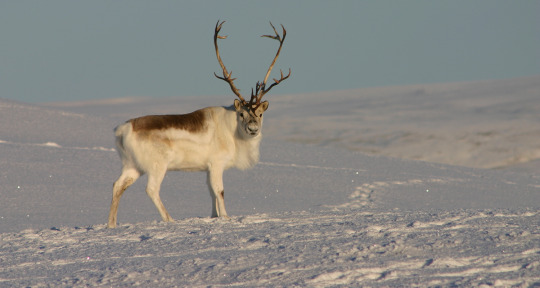
Image taken from Nature Canada.
The Species at Risk Act (SARA), introduced to Canada in 2002, has this subspecies of caribou listed as endangered. Because this species can only be found in the Northwest Territories and Nunavut, it is Canada’s job to protect our current populations. This caribou feeds on arctic vegetation, which is only available for a few months of the summer. During this short period of time, if the females are able to gain enough weight, they would ideally be able to reproduce annually. This rate of reproduction is all dependent on the severity of the passing winters, which vary from year to year. Multiple harsh winters in a row can wipe out an entire herd, whereas multiple mild winters in a row can reduce the caribou’s ability to travel from island to island and lead to a decrease in foraging ability. The warmer winters can lead to population growth, but with limited foraging the population will eventually take a hit. This reduction in population size decreases their genetic diversity, increases the rate of inbreeding and will therefore make them more susceptible to extinction. Other risks for this species include predation, habitat competition and hunting.
2) Blanding’s Turtle (Emydoidea blandingii)

Image taken from Wildlife Preservation Canada.
The Blanding’s Turtle is another species that is listed as endangered under. Approximately 20% of the global abundance can be found in Ontario, Quebec and Nova Scotia. You can find these turtles in lakes, streams, marshes and swamps, as they prefer shallow water with lots of vegetation and nutrients. Females leave the water and look for nesting sites to lay clutches of 3-19 eggs every 2 or 3 years. Natural predators of this species include coyotes, skunks, foxes and racoons raiding the nesting sites. The real threat to the Blanding Turtle comes from increased human activity, as wetlands become more developed and increased traffic heightens the risk of vehicles striking and killing them.
3) Gray Fox (Urocyon cinereoargenteus)

Image taken from the government of Ontario’s website.
The Gray Fox has been listed as a threatened species under SARA and a 2015 assessment from the Committee on the Status of Endangered Wildlife in Canada (COSEWIC). This species of fox is part of the dog family (Canidae) and can be found in Manitoba, Ontario, and Quebec. This nocturnal species feeds on small rodents and vegetable matter, making it easy to inhabit both deciduous forests and the outskirts of cities. The Gray Fox disappeared from Canada during the European settlement and did not return until the 1930’s and 1940’s, as the US populations expanded their ranges northward. Sightings of this fox species is very rare and due to this, the explanation for the decline in its population is unknown. The predicted threats are vehicle collisions, canine distemper, rabies and predation from larger predator species.
I have just told you about three endangered or threated Canadian species that most people don’t know about, but there are still so many more! You may feel like you have no impact on them, but every little bit helps! So, if you see a Gray Fox report your sighting to The Ministry of Natural Resources or if you see a turtle trying to cross the road, help it along in the direction it is travelling. You have an impact and your actions can make a difference!
References
Berrigan, M. (2018, October 15). Blanding's Turtle. Retrieved from https://naturecanada.ca/discover-nature/endangered-species/blandings-turtle/.
Leishman, C. (2018, October 15). Gray Fox. Retrieved from https://naturecanada.ca/discover-nature/endangered-species/gray-fox/.
Peary Caribou. (2018, October 15). Retrieved from https://naturecanada.ca/discover-nature/endangered-species/peary-caribou/.
1 note
·
View note
Text
Fwd: Postdoc: UManitoba.SturgeonEvolution
Begin forwarded message: > From: [email protected] > Subject: Postdoc: UManitoba.SturgeonEvolution > Date: 9 April 2020 at 07:48:50 BST > To: [email protected] > > > > Postdoctoral Position in Sturgeon genomics and transcriptomics > > Under the Canadian Species At Risk Act the Committee on the Status > of Endangered Wildlife in Canada (COSEWIC) recently reaffirmed their > recommendation that Lake Sturgeon be listed as endangered or of special > concern across Canada. Three of the four designatable units of Lake > Sturgeon populations in Canada are found in Manitoba and an intensive > research effort supported by NSERC and Manitoba Hydro in partnership > with indigenous stakeholders, conservation groups, and provincial and > federal legislative bodies has been ongoing for at least the last five > years forming part of a long-term commitment to augment, conserve > and sustain populations of Lake Sturgeon throughout the province > and North America. Understanding underlying genetic variation within > these populations is key to the success of this research effort. In > collaboration with colleagues from UC Davis this research will develop > tools to sequence, assemble and annotate the polyploid genome of Lake > Sturgeon providing a valuable resource for understanding phenotypic > development during early life history and therefore development of > appropriate rearing practices for stock enhancement programs. > > A maximum of four years of funding is available for a post-doctoral > salary commensurate with NSERC guidelines. This position will be > responsible for directing genome sequencing, assembly and annotation > of the lake Sturgeon genome. Additionally, existing transcriptomic > datasets will be available for assessment of transcriptomic responses to > environmental factors in Lake Sturgeon related to growth and regulation > of pH balance. The successful candidate will join a multidisciplinary > research team examining environment phenotype interactions during early > life history and developing tools for improving our use of eDNA and > elemental signatures to understand effectiveness of stock enhancement > strategies in the conservation of this ancient species. Extensive > knowledge and experience in the use of bioinformatic tools is an essential > for this position, prior experience in working with polyploid datasets > is a distinct asset. Interested candidates should email a cover letter > and CV to Dr. W. Gary Anderson [email protected]. > > > Dr. W. Gary Anderson, > > Professor, > Dept. Biological Sciences, > Room 475 Duff Roblin Building, > University of Manitoba, > Winnipeg, MB > Canada, R3T 2N2 > Tel: (204) 474-7496 > > Gary Anderson >
via IFTTT
0 notes
Photo

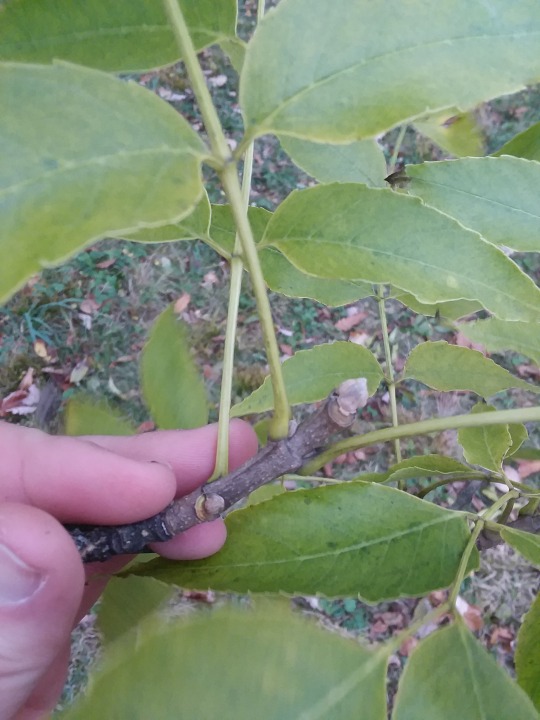


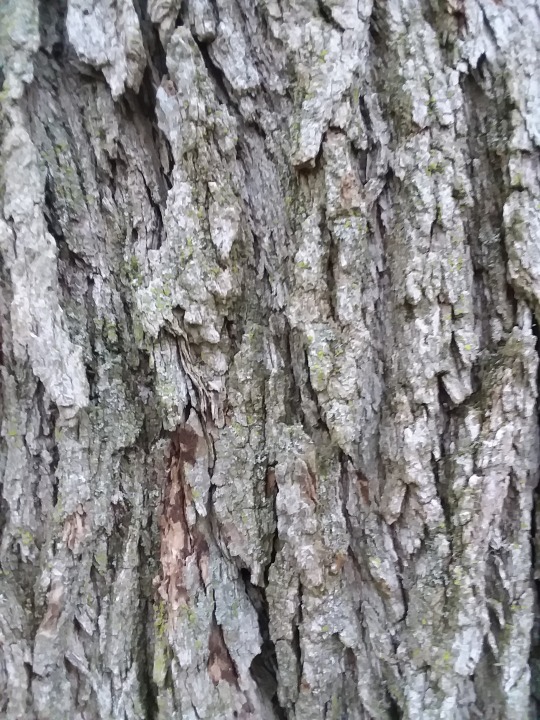

Blue Ash
Fraxinus quadrangulata
Family:
Oleaceae
Regions:
Native to Central U.S.
Mature Size:
Height: 50′ to 75′
Width: 35′ to 60′
Habitat:
Commonly found in rocky woodlands. Prefers humusy loam with average moisture in full sun, but very tolerant to dry soils.
Hardiness Zone:
4 to 7
Leaf Color:
Summer - Dark green
Fall - Pale yellow
Flowers:
Color - Purple
Bloom - April, May
Nesting:
Birds:
Fraxinus quadrangulata provides a suitable nesting site for many species of bird that eat its seeds.
Insects:
Fraxinus quadrangulata provides a suitable for a large number of insect species.
Sources:
http://www.missouribotanicalgarden.org/PlantFinder/PlantFinderDetails.aspx?kempercode=a869
https://www.mortonarb.org/trees-plants/tree-plant-descriptions/blue-ash-not-recommended
https://www.registrelep-sararegistry.gc.ca/virtual_sara/files/cosewic/sr_Blue%20Ash_2014_e.pdf
0 notes
Photo
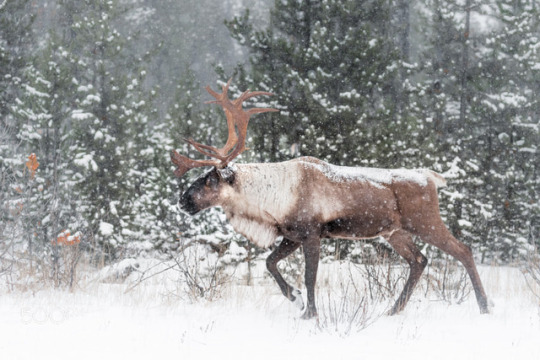
Blizzard Caribou Snow starts to cover the back of this large stag as it continues its never ending search for food. This is another shot from last weekend’s successful Central Mountain Caribou search. The situation has been described as dire for the Central Mountain Caribou population by the Federal Committee on the Status of Endangered Wildlife in Canada (COSEWIC). Numbers of Central Mountain Caribou across Alberta and B.C declined by 60 per cent between 2004 and 2014 to just over 500 mature individuals in 11 herds. For more information on this specific herd see my last post from a few days ago. Love Life, Love Photography
#forest#winter#cold#bush#walking#woods#male#snow fall#frosty#reindeer#antlers#buck#endangered#heavy s
1 note
·
View note